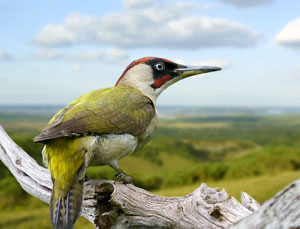Masters of the Sky: The Peregrine Falcon
The British Peregrine Falcon (Falco peregrinus) represents the epitome of speed, agility, and raw might. In the world of bird predators, the peregrine falcon is unrivalled. This extraordinary raptor, which may be found throughout the United Kingdom in a variety of environments, captures the attention of both serious birdwatchers and casual onlookers. Here, we explore the fascinating world of the Peregrine Falcon as we delve into its traits, environment, habits and state of conservation.

Characteristics and Appearance:
The Peregrine Falcon is an incredible physical specimen of a bird. It is designed for rapid aerial pursuits, with a body that is streamlined and a wingspan that may extend up to one metre. It is easily recognised by its striking blue-gray plumage, white underparts with black markings, and sharp, hooked beak. However, its incredible speed—which can reach over 240 mph (386 km/h) when stooping (high-speed diving)—may be its most well-known feature.
Habitat and Distribution:
The Peregrine Falcon is an adaptable resident of a wide range of environments, including metropolitan skyscrapers, rocky cliffs, and seaside shorelines. In recent years, these versatile raptors have grown more prevalent in urban settings, where they nest atop towering buildings and bridges, despite formerly being associated with isolated cliffs and upland places. They can be found all over the UK, although their strongholds are mostly found in Scotland, Wales, and northern England.
Behaviour and Hunting Strategy:
Famous for their stunning hunting methods are peregrine falcons. Their main food source is other birds, and they frequently use stunning dives to catch their prey in midair after high-altitude flights. The word “peregrine” itself means “wanderer” or “traveller,” which accurately describes the migratory behaviour of these birds when they migrate across great distances.
Breeding and Nesting:
Peregrine Falcon courting and breeding routines are fascinating to observe. Vocalisations and elaborate aerial displays are utilised to form and reinforce pair bonds. Year after year, the falcons frequently return to the same eyries, or breeding locations. These eyries may be found perched atop cliff faces, rocky outcrops, or—more frequently—urban constructions like tall buildings and industrial facilities.
Conservation and Recovery:
The Peregrine Falcon has encountered its fair share of difficulties, especially in the middle of the 20th century when the usage of pesticides, particularly DDT, led to a sharp fall in population. These substances caused thinned eggshells and decreased fertility. However, Peregrine Falcon populations made a stunning comeback because to the DDT ban and committed conservation initiatives. Their success tale demonstrates the tenacity of nature and the value of conservation efforts.
Peregrine Falcons and Urban Life:
A fascinating feature is the peregrine falcon’s adaption to urban settings. Their extraordinary adaptability is demonstrated by their ability to flourish amidst the steel and concrete of urban environments. Urban peregrines have drawn the interest of both city dwellers and photographers, offering a rare chance to see these magnificent birds up close.
Present day; The Peregrine Falcon:
Seeing a British Peregrine Falcon in action is a great privilege for birdwatchers, photographers, and nature lovers. Their exhilarating aerial displays, lightning fast dives, and steady presence serve as constant reminders of the delicate beauty and resiliency of the natural world.
The British Peregrine Falcon really does represent the accuracy, grace, and tenacity of nature. It is a prized resident of the varied landscapes of the UK because it serves as a potent predator and a representation of effective conservation efforts. May we be motivated to conserve and preserve the environments that enable these amazing raptors to flourish and beautify our skies for countless generations as we continue to study and admire them.




